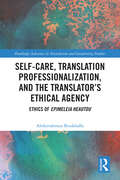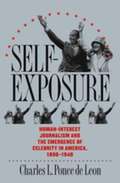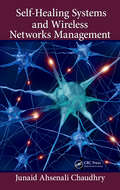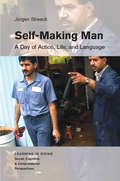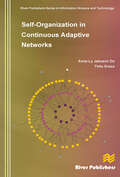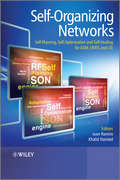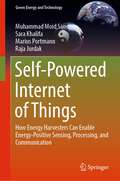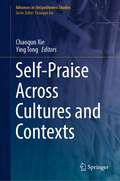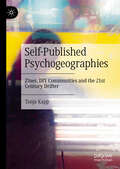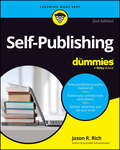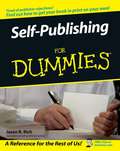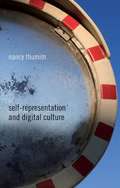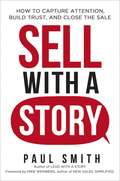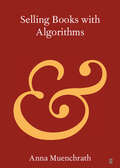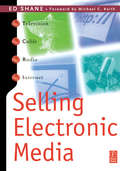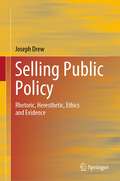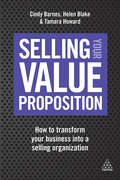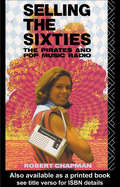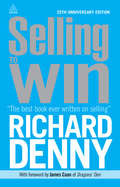- Table View
- List View
Self-Care, Translation Professionalization, and the Translator’s Ethical Agency: Ethics of Epimeleia Heautou (ISSN)
by Abderrahman BoukhaffaThis book draws on an interdisciplinary approach to investigate the impact of codes of ethics as prescribed in translator organizations, proposing alternative ethical pathways grounded in self-care ethics to enhance translators’ symbolic recognition and ethical agency.The volume seeks to provide a counterpoint to existing views in translation studies research on ethics by building on work in sociology and philosophical genealogy, particularly Foucault’s notion of Epimeleia Heautou, to establish a framework of self-care ethics. Featuring analyses of various codes of ethics across different professional associations, the book offers a critical examination of the potential impact of codified ethics on translator autonomy and symbolic status and in turn, their broader social and planetary responsibilities within their roles as translators beyond the translation community. In setting out an alternative charter of ethics which promotes a culture of the self within larger institutions and critical pedagogy within translator education programs, the volume charts new directions in emergent debates on ethics in translation practice.This book will appeal to scholars in translation and interpreting studies, particularly those interested in ethics and sociological and philosophical approaches within the discipline.
Self-Defense for Women: Fight Back
by Loren W. Christensen Lisa Christensen"Somewhere in America right now are four or five women who will be killed tomorrow. They are going about their day, and I know if they were prepared to counter attack in the ways Loren and Lisa Christensen teach, they'd have a far better chance of prevailing tomorrow." --Gavin de Becker, best-selling author of The Gift of Fear.Some "experts" say you should be submissive when attacked at home or by a stranger. You won't find that advice here, although you might use it as a ruse before you claw your assailant's eyes and smash his groin. Your ultimate goal is to get away, but you don't achieve that by being meek and docile. You get away by drawing on that hardwired survival instinct to attack him like an enraged lioness protecting her babies.In Self-Defense for Women: Fight Back, martial arts experts Loren W. Christensen and Lisa Christensen teach you to use your hands, forearms, elbows, teeth, knees, and feet to survive the attacks unsuspecting women become the victims of every day. And you will learn that you're surrounded by a limitless cache of weapons you can use to your advantage against a larger assailant.* How to recognize and assess a threat* How to de-escalate a bad situation* 7 basic defensive techniques any woman can use effectively* Advanced skills for when you want to know more* How to identify and use everyday objects as defensive weapons* What to practice to prepare for a potential confrontation* How to practice at home, alone, and with a partner* Why you need to be physically fit and how to make a fitness plan* How to use fear as a weapon* The power of your mind and how to harness it for self-defenseIf you're ready to learn to fight back, Loren and Lisa know exactly what you need to survive an attack in your home or on the street.
Self-Exposure
by Charles L. Ponce de LeonFew features of contemporary American culture are as widely lamented as the public's obsession with celebrity--and the trivializing effect this obsession has on what appears as news. Nevertheless, America's "culture of celebrity" remains misunderstood, particularly when critics discuss its historical roots. In this pathbreaking book, Charles Ponce de Leon provides a new interpretation of the emergence of celebrity. Focusing on the development of human-interest journalism about prominent public figures, he illuminates the ways in which new forms of press coverage gradually undermined the belief that famous people were "great," instead encouraging the public to regard them as complex, interesting, even flawed individuals and offering readers seemingly intimate glimpses of the "real" selves that were presumed to lie behind the calculated, self-promotional fronts that celebrities displayed in public. But human-interest journalism about celebrities did more than simply offer celebrities a new means of gaining publicity or provide readers with the "inside dope," says Ponce de Leon. In chapters devoted to celebrities from the realms of business, politics, entertainment, and sports, he shows how authors of celebrity journalism used their writings to weigh in on subjects as wide-ranging as social class, race relations, gender roles, democracy, political reform, self-expression, material success, competition, and the work ethic, offering the public a new lens through which to view these issues.
Self-Healing Systems and Wireless Networks Management
by Junaid Ahsenali ChaudhryDo you believe in open-source development? Would you like to see your security system grow and learn by itself? Are you sick of paying for software license fees every year that produce little return on investment? And, would you prefer to invest in something you could sell later on to other IT security departments? If you answered yes to these ques
Self-Making Man: Social, Cognitive and Computational Perspectives)
by Jürgen StreeckThis book portrays one day in the communicative life of the owner of an auto repair-shop in Texas. He walks, looks, points, shows and explains engines, makes sense by gesture, speaks, manages, makes his life-world, and in the process reproduces social structures and himself as individual. Self-Making Man is the first comprehensive study of a communicating person; it reveals socially shared and personal practices, as well as improvisational actions by which a person inhabits and makes sense of the world with others. After decades of discussion on embodiment, this study is the first to investigate one body in its full range of communicative activities. Grounded in phenomenology and committed to the methodological rigor of context analysis and conversation analysis, Self-Making Man departs radically from contemporary research practice: it shows that, to take embodiment in human interaction seriously, we must conceive of it as individuation and organic, self-sustaining life: as autopoeisis. Proposes a new perspective on embodiment in social interaction. Rich in ethnographic detail and shows how all of the human senses are deployed moment by moment in 'sense-making' and social interaction. Provides new empirical insights into communication modalities (gaze, gesture, speech, etc.) and their roles in social interaction.
Self-Organization in Continuous Adaptive Networks (River Publishers Series In Information Science And Technology Ser.)
by Thilo Gross Anne-Ly DoIn the last years, adaptive networks have been discovered simultaneously in different fields as a universal framework for the study of self-organization phenomena. Understanding the mechanisms behind these phenomena is hoped to bring forward not only empirical disciplines such as biology, sociology, ecology, and economy, but also engineering disciplines seeking to employ controlled emergence in future technologies. This volume presents new analytical approaches, which combine tools from dynamical systems theory and statistical physics with tools from graph theory to address the principles behind adaptive self-organization. It is the first class of approaches that is applicable to continuous networks. The volume discusses the mechanisms behind three emergent phenomena that are prominently discussed in the context of biological and social sciences:• synchronization,• spontaneous diversification, and• self-organized criticality.Self-organization in continuous adaptive networks contains extended research papers. It can serve as both, a review of recent results on adaptive self-organization as well as a tutorial of new analytical methodsSelf-organization in continuous adaptive networks is ideal for academic staff and master/research students in complexity and network sciences, in engineering, physics and maths.
Self-Organizing Networks (SON)
by Juan Ramiro Khalid HamiedWith the current explosion in network traffic, and mounting pressure on operators' business case, Self-Organizing Networks (SON) play a crucial role. They are conceived to minimize human intervention in engineering processes and at the same time improve system performance to maximize Return-on-Investment (ROI) and secure customer loyalty.Written by leading experts in the planning and optimization of Multi-Technology and Multi-Vendor wireless networks, this book describes the architecture of Multi-Technology SON for GSM, UMTS and LTE, along with the enabling technologies for SON planning, optimization and healing. This is presented mainly from a technology point of view, but also covers some critical business aspects, such as the ROI of the proposed SON functionalities and Use Cases.Key features:Follows a truly Multi-Technology approach: covering not only LTE, but also GSM and UMTS, including architectural considerations of deploying SON in today's GSM and UMTS networksFeatures detailed discussions about the relevant trade-offs in each Use CaseIncludes field results of today's GSM and UMTS SON implementations in live networksAddresses the calculation of ROI for Multi-Technology SON, contributing to a more complete and strategic view of the SON paradigmThis book will appeal to network planners, optimization engineers, technical/strategy managers with operators and R&D/system engineers at infrastructure and software vendors. It will also be a useful resource for postgraduate students and researchers in automated wireless network planning and optimization.
Self-Powered Internet of Things: How Energy Harvesters Can Enable Energy-Positive Sensing, Processing, and Communication (Green Energy and Technology)
by Raja Jurdak Marius Portmann Muhammad Moid Sandhu Sara KhalifaThis book covers cutting edge advancements on self-powered Internet of Things, where sensing devices can be energy-positive while capturing context from the physical world. It provides new mechanisms for activity recognition without the need of conventional inertial sensors, which demand significant energy during their operation and thus quickly deplete the batteries of internet-of-things (IoT) devices. The book offers new solutions by employing energy harvesters as activity sensors as well as power sources to enable the autonomous and self-powered operation of IoT devices without the need of human intervention. It provides useful content for graduate students as well as researchers to understand the nascent technologies of human activity, fitness and health monitoring using autonomous sensors. In particular, this book is very useful for people working on pervasive computing, activity recognition, wearable IoT, fitness/healthcare and autonomous systems.This book covers a broad range of topics related to self-powered activity recognition. The main topics of this book include wearables, IoT, energy harvesting, energy harvesters as sensors, activity recognition and self-powered operation of IoT devices. This book starts with the introduction of wearable IoT devices and activity recognition and then highlights the conventional activity recognition mechanisms. After that, it describes the use of energy harvesters to power the IoT devices. Later, it explores the use of various energy harvesters as activity sensors. It also proposes the use of energy harvesters as simultaneous source of energy and context information and defines the emerging concept of energy-positive sensing compared to conventional energy-negative sensing. Finally, it explores sensor/signal fusion to enhance the performance using multiple energy harvesters and charts a way forward for future research in this area. This book covers all important and emerging topics that have significance in the design and implementation of autonomous wearable IoT devices. We believe that this book will lay the foundation for designing self-powered IoT devices which can ultimately replace the conventional wearable IoT devices which need regular recharging and replacement.
Self-Praise Across Cultures and Contexts (Advances in (Im)politeness Studies)
by Chaoqun Xie Ying TongThis book explores the extent to which self-praise is acceptable in both offline and online contexts, across different genres, platforms, and cultural backgrounds. The data analyzed encompass both naturally occurring (daily conversation as well as institutional talk) and elicited (experiments and interviews) types, and are explored at both quantitative and qualitative levels to offer a relatively systematic and comprehensive inquiry into self-praise as social (inter)action. Contributors to this book not only draw on traditional politeness theories but are also informed by social psychology, interactional sociolinguistics, CMC, and (multimodal) discourse analysis. They are inspired by pragmatics but also go beyond to ground their studies within locally situated cultural contexts, most of which are under-presented in the current academic world. Their efforts substantiate the fact that self-praise is most worthy of intensive analytic attention. This book appeals to students and researchers in the field and contributes to the way communication is facilitated through different ways of deploying linguistic and interactional resources.
Self-Published Psychogeographies: Zines, DIY Communities and the 21st Century Drifter
by Tanja KappThis book explores the world of psychogeographical walking as portrayed in zines – self-made, low-budget publications circulated within DIY communities. Termed "new psychogeography", the representation of these mobilities in zines challenge conventional dualisms, favoring peripheral spaces and polyphonic perspectives over urban-centric voyeurism. Through four case studies, the book explores the evolution of the contemporary drifter, emphasizing a departure from conquering cityspaces through stalking to exploring how spaces shape memory, experience, and notions of home. Pioneering research at the intersection of zine and travel writing studies, it unveils the psychogeographical mediality inherent to this medium.
Self-Publishing For Dummies
by Jason R. RichGet your books into the hands of readers with this simple how-to guide Self-Publishing For Dummies takes you through the entire process of publishing your own books, starting with the writing and editing process and moving through cover design, printing options, distribution channels, and marketing to a target audience. With the advice in this book, you can tackle self-publishing, no matter what genre you write in. You’ll learn how to retain full control over your work and keep the profits from the sales of your book. In this updated edition, you’ll discover the latest technologies in self-publishing, trends in the world of ebooks, and new marketing techniques you can use online and in the real world. Becoming a published author is easier than ever, thanks to this Dummies guide. Understand every step in the self-publishing process Discover how to write and sell your books in ebook and printed formats Hire an editor, obtain an ISBN, and generate publicity for your book Fine-tune your writing to improve your chances of success Get your work out there—no agent or publisher neededSelf-Publishing For Dummies is the perfect choice for anyone with an interest in DIY publishing.
Self-Publishing For Dummies (For Dummies Ser.)
by Jason R. RichCovers budgeting, copyrighting, and marketing Know the pros and cons of self-publishing and get your work in print Thinking about self-publishing your book? This no-nonsense guide walks you through the entire process of going it alone, from preparing your manuscript and creating the perfect title to selling the final product. You'll see how to obtain an ISBN, work with printers and distributors, create a buzz with publicity, and take advantage of electronic publishing. Discover how to * Start your own publishing company * Edit your work effectively * Design and format your book * Hire skilled professionals to help * Manage outside vendors * Build awareness for your book online
Self-Representation and Digital Culture
by Nancy ThumimTaking a close look at ordinary people 'telling their own story', Thumim explores self-representations in contemporary digital culture in settings as diverse as reality TV, online storytelling, and oral histories displayed in museums. Now available in paperback, Self-Representation and Digital Culture addresses the institutional contexts of production, technology and form of the texts, and the point of view of those who represent themselves. This highly original research examines how contradictory and widely different politics inform and shape examples of 'speaking for oneself'. In the book, Thumim argues that analysis and theorization of the activity of self-representation is vital for media, communication and cultural studies at a time when examples, of what should now be understood as a genre, both surround us and appear, at first glance, to all be alike.
Sell Like A Spy: The Art of Persuasion from the World of Espionage
by Jeremy HurewitzSecond installment of the international bestseller, The Club.With a foreword by Robert Grenier, former Director of the CIA's Counterterrorism Center, learn the art of influence from the best salespeople in the world—spies. Tapping into the history of intelligence-gathering and his work with former agents of the CIA, FBI, and other federal departments, Jeremy Hurewitz, a foremost corporate sales and security expert, offers field-tested spycraft strategies and government-agency tactics anyone can use to build relationships, persuade, and sell anything.Hurewitz has built his career around CIA case officers, FBI agents, and government officials—people like Steve Romano, former Chief Negotiator of the FBI; Mark Sullivan, former Director of the Secret Service; General Stanley McChrystal (Ret.), former Commander of the Joint Special Operations Command; and John Cipher, former member of the CIA's Senior Intelligence Service. Drawing on in-depth interviews about their skillsets, stunning spy-world anecdotes, and science-backed principles of behavioral intelligence, Hurewitz has created a handbook of lessons and techniques that will strengthen your ability to connect, entice, and make deals—in business and everyday life.Though a spy's targets may be odious—terrorists, criminals, corrupt diplomats, and more—the agent's focus is on cultivating relationships and understanding motivations to gather information, free hostages, or procure money. Elicitation, Radical Empathy, and RPM (Rationalize, Project Blame, and Minimize Fault) are just a few methods in this persuasion playbook from the real world of international espionage.With a foreword by Robert Grenier, former Director of the CIA's Counterterrorism Center, Sell Like a Spy puts James Bond in its dust, making you a true agent of persuasion.
Sell Online Like a Creative Genius: A Guide for Artists, Entrepreneurs, Inventors, and Kindred Spirits (Like a Creative Genius #1)
by Brainard CareyHow to sell art or anything else online without leaving your home. Whether you’re selling original artwork, jewelry, or a unique product, this is the book for you. Brainard Carey offers advice with solid examples of how building an online business is something every creative person can pursue. Carey draws from his extensive experience and interviews with others to show artists and creative people how to sell their work independently and efficiently. Readers will learn how to establish an online store, develop a presence, promote their goods, and reach customers. Chapter topics include: Designing a website or profile on an existing site Effective marketing strategies Creative ways to advertise your product Building your social media following Finding new customers Real examples of artists and entrepreneurs who succeeded in selling their work online And much more With chapters divided between practical how-tos and case studies, Sell Online Like a Creative Genius™, offers readers both instructive and demonstrative lessons in making their small online business a reality. Everyone can do it with the right tools, and Carey offers an insider’s guide to an otherwise daunting process.
Sell with a Story: How to Capture Attention, Build Trust, and Close the Sale
by Paul SmithDespite the high-tech tools available to salespeople today, the most personal method still works best. Through storytelling, a salesperson can explain products or services in ways that resonate, connect people to the mission, and help determine what decisions are made.A well-crafted story can pack the emotional punch to turn routine presentations into productive relationships. In Sell with a Story, organizational storytelling expert and author Paul Smith focuses his popular and proven formula to the sales arena.Smith identifies the ingredients of the most effective sales stories and reveals how to:Select the right story Craft a compelling and memorable narrative Incorporate challenge, conflict, and resolution• And more Learning from model stories, skill-building exercises, and enlightening examples from Microsoft, Costco, Xerox, Abercrombie & Fitch, Hewlett-Packard, and other top companies, you will soon be able to turn their personal experiences into stories that introduce yourself, build rapport, address objections, add value to the product, bring data to life, create a sense of urgency…and most importantly, sell!If you want to become a better communicator and transform your sales results, Sell with a Story is for you.
Selling Books with Algorithms (Elements in Publishing and Book Culture)
by Anna MuenchrathIn 1997 Amazon started as a small online bookseller. It is now the largest bookseller in the US and one of the largest companies in the world, due, in part, to its implementation of algorithms and access to user data. This Element explains how these algorithms work, and specifically how they recommend books and make them visible to readers. It argues that framing algorithms as felicitous or infelicitous allows us to reconsider the imagined authority of an algorithm's recommendation as a culturally situated performance. It also explores the material effects of bookselling algorithms on the forms of labor of the bookstore. The Element ends by considering future directions for research, arguing that the bookselling industry would benefit from an investment in algorithmic literacy.
Selling Electronic Media
by Ed Shane"Selling is identifying and satisfying customer needs profitably. Profitable for you, profitable for them."Diane Sutter, President and CEO of Shooting Star Broadcasting , owner of KTAB-TV, Abilene, TexasThis is the definition of sales used throughout Ed Shane's comprehensive and timely textbook Selling Electronic Media. This new definition reflects the customer-orientation of today's marketing environment as well as the product-orientation of selling. Today's selling is a win/win proposition, a win for the seller and a win for the customer.Using interviews with industry leaders and reports of their selling experiences, Selling Electronic Media shares insight and practical advice in the basics of selling: · prospecting· qualifying· needs analysis· presentations· answering objections· closing· relationship management Focusing on the merging and converging of electronic media and the need for branding of media at all levels, this highly readable book offers complete coverage of advertising sales for radio, television and cable, plus the new and emerging mass communication technologies, primarily those generated by the Internet.Selling Electronic Media is enhanced with review highlights and discussion points and illustrated throughout with visuals used by media outlets to market commercials and their audience reach.Students pursuing sales and marketing careers in electronic media and professionals wishing to reinforce their understanding of the merging and converging media environment will find what they need in the pages of this book.
Selling Public Policy: Rhetoric, Heresthetic, Ethics and Evidence
by Joseph DrewProfessor Drew’s latest work makes the case that even great public policy needs to be deliberately and strategically sold in order for it to ultimately be considered a success. However, it seems that most people charged with the task of selling public policy simply do not have the requisite skills to do so.Selling public policy is an art that draws on disparate strands of scholarship spanning the political sciences, economics, sociology, ethics and the classics. To perform the art of selling public policy one must first master the lessons from the greats in the field. Following this, it is necessary to learn how to apply the knowledge to real-world complex scenarios in such a way that the policy is indeed sold and stays sold over the implied returns period.This book is unique in the corpus of scholarly literature because it provides both the knowledge and real-world case studies required for students, scholars, and policy practitioners to master the art of selling public policy.
Selling Rights
by Lynette OwenNow in its ninth edition, Selling Rights has firmly established itself as the leading guide to all aspects of rights sales and co-publications throughout the world.Covering the full range of potential rights, from English-language territorial rights through to serial rights, permissions, rights for the reading-impaired, translation rights, dramatization and documentary rights, electronic and multimedia rights, this book constitutes a comprehensive introduction and companion to the topic. Besides individual types of rights, topics covered also include book fairs, Open Access, the ongoing impact of new electronic hardware, and the rights implications of acquisitions, mergers, and disposals.This fully updated edition includes:• New IP legislation and proposed legislation in the UK and the USA, including changes regarding TDM and the post-Brexit implications of EU directives and exhaustion of rights.• The implications of artificial intelligence (AI) for author contracts and licensing contracts.• The impact of the pandemic and its aftermath on the promotion and sale of rights.• Coverage of censorship in countries around the world, especially in relation to LGBTQI+ content, as well as political situations which have impacted on rights trading.• The impact of streaming services on opportunities for licensing television and film rights.• Major revisions to the chapters on audio and video recording rights, the internet and publishing, and electronic publishing and digital licensing.Selling Rights is an essential reference tool and an accessible and illuminating guide to current and future issues for rights professionals and students of publishing.
Selling Shakespeare
by Adam G. HooksSelling Shakespeare tells a story of Shakespeare's life and career in print, a story centered on the people who created, bought, and sold books in the early modern period. The interests and investments of publishers and booksellers have defined our ideas of what is 'Shakespearean', and attending to their interests demonstrates how one version of Shakespearean authorship surpassed the rest. In this book, Adam G. Hooks identifies and examines four pivotal episodes in Shakespeare's life in print: the debut of his narrative poems, the appearance of a series of best-selling plays, the publication of collected editions of his works, and the cataloguing of those works. Hooks also offers a new kind of biographical investigation and historicist criticism, one based not on external life documents, nor on the texts of Shakespeare's works, but on the books that were printed, published, sold, circulated, collected, and catalogued under his name.
Selling Your Value Proposition: How to Transform Your Business into a Selling Organization
by Helen Blake Cindy Barnes Tamara HowardA value proposition is created from the combination of a company's products and services, and the value gained by the customer. It is used to drive better business, and is essential to success for any business - without it, companies are at risk of losing customers and being drowned out in crowded marketplaces. Selling Your Value Proposition is a practical, user-friendly guide to establishing a streamlined customer-centric selling process to communicate and express value propositions, enabling companies to convey their value-creating stories to customers consistently. Featuring case studies and interviews with renowned business leaders and influencers, Selling Your Value Proposition demonstrates how value propositions adeptly position a business across a range of industries. The techniques and skills shared have all been honed through the authors' experience with more than 600 companies around the world, and clear, step-by-step guidelines will empower all readers to effectively focus their value propositions for competitive success.
Selling the Great War: The Making of American Propaganda
by Alan AxelrodThe riveting, untold story of George Creel and the Committee on Public Information -- the first and only propaganda initiative sanctioned by the U.S. government.When the people of the United States were reluctant to enter World War I, maverick journalist George Creel created a committee at President Woodrow Wilson's request to sway the tide of public opinion. The Committee on Public Information monopolized every medium and avenue of communication with the goal of creating a nation of enthusiastic warriors for democracy. Forging a path that would later be studied and retread by such characters as Adolf Hitler, the Committee revolutionized the techniques of governmental persuasion, changing the course of history. Selling the War is the story of George Creel and the epoch-making agency he built and led. It will tell how he came to build the and how he ran it, using the emerging industries of mass advertising and public relations to convince isolationist Americans to go to war. It was a force whose effects were felt throughout the twentieth century and continue to be felt, perhaps even more strongly, today. In this compelling and original account, Alan Axelrod offers a fascinating portrait of America on the cusp of becoming a world power and how its first and most extensive propaganda machine attained unprecedented results.
Selling the Sixties: The Pirates and Pop Music Radio
by Robert ChapmanWas it a non-stop psychedelic party or was there more to pirate radio in the sixties than hedonism and hip radicalism? From Kenny Everett's sacking to John Peel's legendary `Perfumed Garden' show, to the influence of the multi-national ad agencies, and the eventual assimilationof aspects of unofficial pop radio into Radio One, Selling the Sixties examines the boom of private broadcasting in Britain. Using two contrasting models of pop piracy, Radios Caroline and London, Robert Chapman sets pirate radio in its social and cultural context. In doing so he challenges the myths surrounding its maverick `Kings Road' image, separating populist consumerism from the economic and political machinations which were the flipside of the pirate phenomenon. Selling the Sixties includes previously unseen evidence from the pirates' archives, revealing interviews and an unrivalled selection of rare audio materials.
Selling to Win
by Richard DennyRichard Denny is the "godfather of salesmanship" and Selling to Win has established itself as an international best-seller and classic sales text. One of the world's most inspirational business speakers, Richard has helped countless thousands of salespeople to become high flyers, and in this bestselling book he explains how to put his winning techniques into action. This 25th anniversary edition of Selling to Win has been fully revised and updated and is packed with even more unbeatable sales tips. You'll find tried and tested advice on how to: get a sale when you are not the cheapest; beat the competition; turn your customer into an ambassador; build a positive attitude that gets results; close a sale. Recognized worldwide as one of the most effective and powerful sales-improvement guides ever written, Selling to Win is the salesperson's bible.
